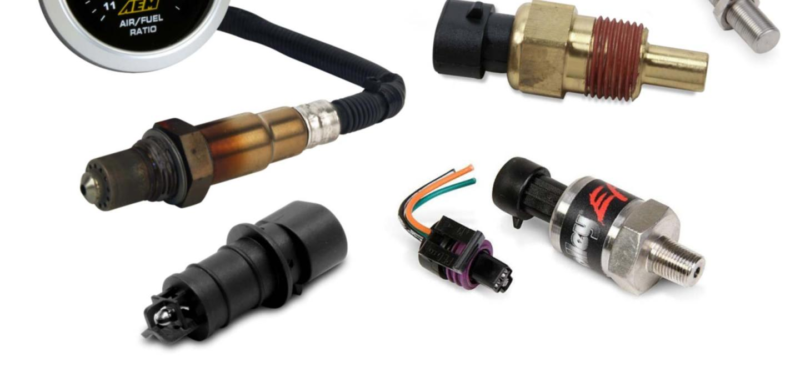In the complex field of automotive engineering, every component plays a crucial role in ensuring the smooth and efficient operation of a vehicle. Among these, engine sensors constantly monitor and control various parameters to maintain engine stability. In this article, we delve into the functions and importance of these key sensors in a gasoline engine, revealing their often overlooked yet pivotal role in our daily journeys.
Table of Contents
Types and Working Principles of Crankshaft Position Sensors
Translation: There are mainly three types of crankshaft position sensors: electromagnetic induction type, Hall effect type, and photoelectric effect type.
Electromagnetic Induction Type
The electromagnetic induction type consists of a signal wheel, a permanent magnet, an iron core sensor head, and an induction coil. When the signal wheel rotates, the magnetic flux between the sensor head and the signal wheel changes with the convex and concave changes of the signal wheel gears and slots, thereby inducing an AC signal on the induction coil. The ECU (Engine Control Unit) can calculate the engine speed and crankshaft angle based on the number and period of these output signals and the relationship with the engine speed. This type of sensor has the advantages of simple structure and low cost, but the disadvantage is that the output voltage may fluctuate with changes in engine speed.
Hall Effect Type
This type of sensor uses the Hall effect, that is, when a current flows through the Hall semiconductor substrate perpendicular to the direction of the magnetic field, a potential difference proportional to the current and magnetic field strength, i.e., the Hall voltage, is generated on the two lateral sides of the substrate. The sensor consists of a signal wheel (with blades or trigger gears) and a Hall signal generator (including a permanent magnet, a magnetic guide plate, and a Hall integrated circuit). When the blade turns into the gap between the Hall element and the magnet, the Hall signal generator outputs a high-level signal. The ECU can calculate the engine speed and crankshaft angle based on the number and period of these output signals and the relationship with the engine speed. This type of sensor has the advantage that the output voltage is not affected by engine speed, but due to the number of blades or trigger wheel teeth being limited by its own structure, there is a problem of coarse indexing.
Photoelectric Effect Type
The photoelectric effect type sensor consists of a signal wheel (with blades) and a signal generator (including a light-emitting diode, a photosensitive diode, and an amplifying shaping circuit). When the signal wheel rotates, every time a blade enters the gap between the light-emitting diode and the photosensitive diode, the voltage of the photosensitive diode is zero; when the blade leaves the gap between the two, the photosensitive diode generates voltage due to light sensing. The ECU can calculate the engine speed and crankshaft angle based on the number and period of the voltage pulse signals output by the signal generator and the relationship with the engine speed. This type of sensor has the advantage of high indexing accuracy and digital pulse output signals, but the disadvantage is that it has high requirements for the operating environment.
Common Engine Sensors
With the rapid development of automobiles, automobile manufacturers around the world have put a lot of effort into the functions, software and hardware of automobiles. All high-end automobiles will use more sensors. Below we will introduce some commonly used engine sensors. Without these most commonly used sensors, many cars will have problems even starting the engine.
Crankshaft Position Sensor
The crankshaft position sensor is a very important engine management system sensor. Its main task is to provide engine speed and crankshaft position information to the engine control unit (ECU). This information is crucial for controlling fuel injection and ignition timing. If the crankshaft position sensor fails, the engine may not start or run.
Camshaft Position Sensor
The function of the camshaft position sensor is similar to that of the crankshaft position sensor, but it monitors the position and speed of the camshaft. This information is very important for determining the precise timing of fuel injection and the ignition sequence. The camshaft position sensor can also help the system determine whether the engine is in the compression stroke or the exhaust stroke, which is very important for fuel management when the engine starts.
Knock Sensor
The knock sensor, also known as a detonation sensor or vibration sensor, is used to monitor the phenomenon of engine knocking, i.e., the premature autoignition of the fuel-air mixture. Knocking can cause the engine to run unstable, and in severe cases, it may even damage the engine. The knock sensor determines whether knocking has occurred by detecting the vibration frequency of the engine. If knocking is detected, the engine control unit (ECU) will immediately adjust the ignition timing to allow the mixture to burn at the appropriate time to prevent knocking.
Therefore, for the safety of the car engine, a damaged knock sensor must be replaced in time. Otherwise, it will affect driving safety.
In addition to the crankshaft position sensor, camshaft position sensor, and knock sensor, other common engine sensors include the throttle position sensor, airflow sensor, oxygen sensor, coolant temperature sensor, and oil pressure sensor. These sensors work together to ensure efficient and safe operation of the engine.
Conclusion
In conclusion, sensors in gasoline engines, including electromagnetic induction, Hall effect, and photoelectric effect sensors, play a crucial role in ensuring efficient and safe operation of the engine. Although each type of sensor has its unique advantages and disadvantages, through careful design and selection, they can provide accurate and reliable performance under various operating environments and conditions. With the advancement of technology, we can expect more advanced and efficient sensor technologies to continue to drive the development of gasoline engines and the broader mechanical field.
